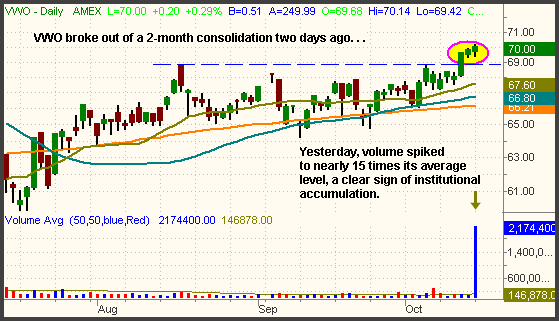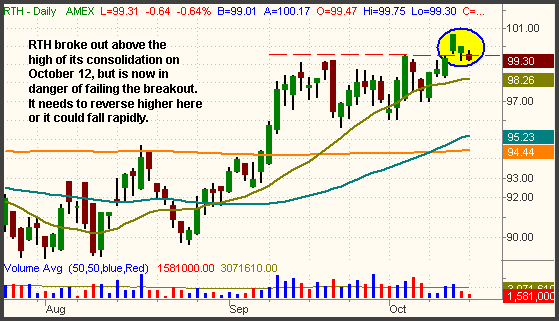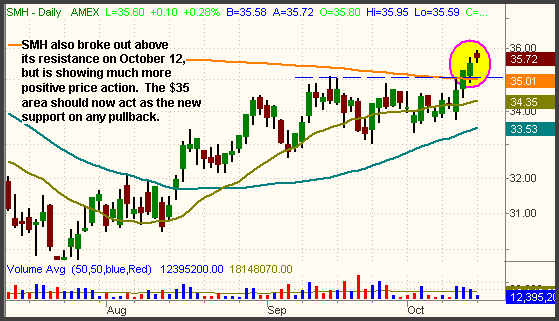Stocks continued to show great resiliency by edging higher yesterday, but it was the third consecutive session of lower volume gains. Both the S&P 500 and Nasdaq Composite advanced 0.3%, while the Dow Jones Industrial Average closed 0.2% higher. Small-cap stocks clearly outperformed again, as the Russell 2000 Index rallied 0.9%. The S&P Midcap 400 trailed closely behind with a 0.7% gain. It's positive that small and mid-cap stocks have shown relative strength over the past several days because leading stocks are typically small or mid-cap issues. Most long-term bull markets are not led by the blue-chip giants, but by fundamentally strong, high-growth stocks whose gains outpace the major indices by a whopping margin.
Total volume in both exchanges declined by 4% from the previous day's levels, failing once again to confirm the broad-based gains. Volume in the NYSE came in below its 50-day average level for the first time in five sessions, but Nasdaq turnover was still above average.Just as healthy markets will occasionally flash one or two days of higher volume selling ("distribution") along the way, it is normal to occasionally have a few sessions of lighter volume gains. However, a string of three or more days of lower volume gains makes the market more vulnerable to reacting sharply when the bears inevitably step in on the sell side. Conversely, gains on increasing volume show institutional demand is behind the buying pressure, which in turn can easily absorb a day or two of selling. The broad market's price action alone has been fantastic over the past week, but this string of ligher volume "up" days is making us increasingly cautious about an imminent correction that could be substantial since institutional demand has dried up over the past few days.
One ETF that came across our radar with an amazing volume surge was the Vanguard Emerging Markets (VWO). Though it has an average daily volume of only 147,000 shares, more than 2.1 million shares changed hands yesterday. This volume surge came only two days after VWO broke out above the high of a two-month consolidation. Obviously, there is an institution out there who took a big bet on the future prospects of this international ETF:

Because all ETFs are synthetic instruments, remember that actual volume spikes will not directly affect the price of an ETF. Rather, only a corresponding move in the price of the underlying securities will. Nevertheless, volume spikes are always the hallmark of institutional buying or selling. If money continues flowing into the emerging markets ETF, there is a pretty good chance that the underlying stocks will see accumulation as well. With sector trading, our job is simply to spot the institutional money flow and ride on the coattails of mutual funds, hedge funds, and other institutions that have the power to move markets.
Unlike individual stocks, there aren't many low-priced ETFs out there. Of the more than three hundred ETFs that trade on the U.S. markets, there are presently only four trading under $10 per share. But of these four, the Internet Infrastructure HOLDR (IIH) actually has a pretty bullish chart pattern going on. This ETF, comprised mostly of internet software companies such as Akamai (AKAM) and Verisign (VRSN), traded at more than $100 per share when it was launched in the wild "dot com" days. Much to the dismay of Merrill Lynch, IIH was launched in March of 2000, the same month that the Nasdaq peaked over the 5,000 level. Since surviving an amazing collapse that took IIH from $100 in March 2000 all the way down to $1 in October 2002 (yes, you read that right!), it has been steadily recovering (relatively speaking). Since the middle of last month, IIH has been consolidating at nearly a five-year high. It now appears ready to break out of that consolidation and make another leg up:

In addition to its bullish consolidation, notice also how volume has increased beyond average levels over the past month. This, again, is a sign of institutional buying interest in the sector. As you can see, the October 5 high of $5.59 is the top of the consolidation. IIH probed a penny above that level yesterday, but closed a few cents below it. Be on the lookout for a potential breakout in the coming days.
In the October 12, 2006 issue of The Wagner Daily, we pointed out potential long setups in both the Retail HOLDR (RTH) and Semiconductor HOLDR (SMH). As anticipated, both ETFs rallied above our trigger price that same day, but RTH is already in danger of a failed breakout. In case you entered RTH on the breakout above its recent consolidation, let's take an updated look at the chart:

The dashed horizontal line on the chart above marks the trigger for long entry that occurred when RTH rallied above its October 4 high on October 12. Because it was a breakout from nearly a four-week consolidation, momentum from the October 12 breakout should have carried RTH higher. Instead, RTH has already drifted back down to its breakout level only two days later. Since a prior resistance levels always becomes new support after the resistance is broken, RTH should find support and head higher from here, but keep a tight stop if it doesn't! As we have seen many times in the past, breakouts that fail and promptly fall back into the range often generate substantial downward momentum. Not only are the bulls who bought the breakout trapped, but failed breakouts attract short sellers as well. It's okay to give RTH a little "wiggle room" below the 99.52 pivot, but we would not have a stop much lower than the 20-day moving average. If it falls below that level with conviction, the next subsequent bounce would be shortable, but that is only one scenario.
In addition to RTH, we also looked at SMH as a potential buy setup on October 12. Like RTH, it also rallied above its resistance, which was convergence of its September 15 high and its 200-day moving average. But SMH has been showing much better price action that RTH since then. SMH closed at its highest level since May 12 yesterday, confirmation that the tech stocks are acting much better than they were just one week ago:

If you're long SMH, you're looking good so far, but it's wise to be vigilant with the Semiconductor Index ($SOX) sitting right below its 200-day MA. For a stop loss on SMH, the obvious place is just below new support of its 200-day moving average and the prior high, around the 34.70 to 34.80 area. The small profit margin that SMH has generated enables you to nearly have a break-even stop from the original entry above the 35.12 pivot.
Yesterday, we mentioned several important technical resistance levels that the broad market would face this week. These included: 12,000 "psychological resistance" on the Dow, 200-day moving average on the $SOX, and resistance of the 52-week high on the Nasdaq Composite. Curiously, the market came within a hair of testing all these yesterday. The intraday high on the Dow was 11,997, the intraday high on the $SOX perfectly coincided with the 200-MA, and the Nasdaq came within tenths of a percent of its 52-week high. It will certainly be interesting to see how the market reacts to the confluence of all these technical factors over the next day or two. Stay alert out there, honor your stop losses, and lay low until the market decides what it wants to do at this crossroad.
Deron Wagner is the Founder and Head Trader of both Morpheus Capital LP, a U.S. hedge fund, and Morpheus Trading Group, a trader education firm launched in 2001 that provides daily technical analysis of the leading ETFs and stocks. For a free trial to the full version of The Wagner Daily or to learn about Wagner's other services, visit MorpheusTrading.com or send an e-mail to deron@morpheustrading.com.